简单句、并列句和复合句讲课教案
- 格式:ppt
- 大小:61.00 KB
- 文档页数:24
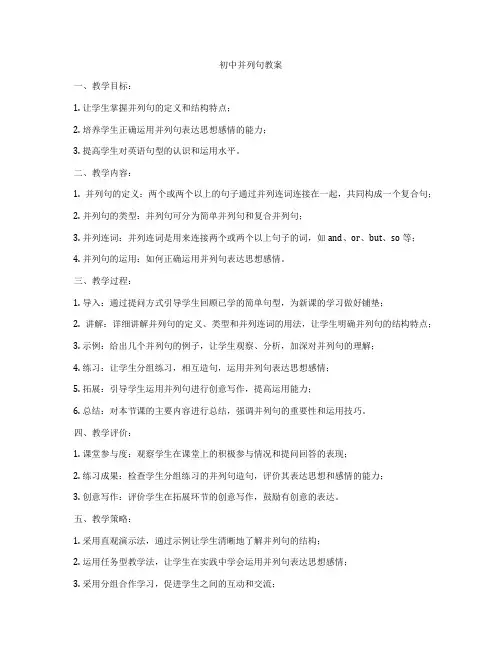
初中并列句教案一、教学目标:1. 让学生掌握并列句的定义和结构特点;2. 培养学生正确运用并列句表达思想感情的能力;3. 提高学生对英语句型的认识和运用水平。
二、教学内容:1. 并列句的定义:两个或两个以上的句子通过并列连词连接在一起,共同构成一个复合句;2. 并列句的类型:并列句可分为简单并列句和复合并列句;3. 并列连词:并列连词是用来连接两个或两个以上句子的词,如and、or、but、so等;4. 并列句的运用:如何正确运用并列句表达思想感情。
三、教学过程:1. 导入:通过提问方式引导学生回顾已学的简单句型,为新课的学习做好铺垫;2. 讲解:详细讲解并列句的定义、类型和并列连词的用法,让学生明确并列句的结构特点;3. 示例:给出几个并列句的例子,让学生观察、分析,加深对并列句的理解;4. 练习:让学生分组练习,相互造句,运用并列句表达思想感情;5. 拓展:引导学生运用并列句进行创意写作,提高运用能力;6. 总结:对本节课的主要内容进行总结,强调并列句的重要性和运用技巧。
四、教学评价:1. 课堂参与度:观察学生在课堂上的积极参与情况和提问回答的表现;2. 练习成果:检查学生分组练习的并列句造句,评价其表达思想和感情的能力;3. 创意写作:评价学生在拓展环节的创意写作,鼓励有创意的表达。
五、教学策略:1. 采用直观演示法,通过示例让学生清晰地了解并列句的结构;2. 运用任务型教学法,让学生在实践中学会运用并列句表达思想感情;3. 采用分组合作学习,促进学生之间的互动和交流;4. 注重个体差异,给予每个学生充分的关注和指导。
六、教学资源:1. 课件:制作精美的课件,展示并列句的定义、类型和并列连词;2. 练习册:提供一些并列句的练习题,巩固所学知识;3. 范文:挑选一些运用并列句表达思想感情的优秀范文,供学生参考。
通过本节课的教学,使学生掌握并列句的基本知识,能够正确运用并列句表达思想感情,提高学生的英语句型运用水平。
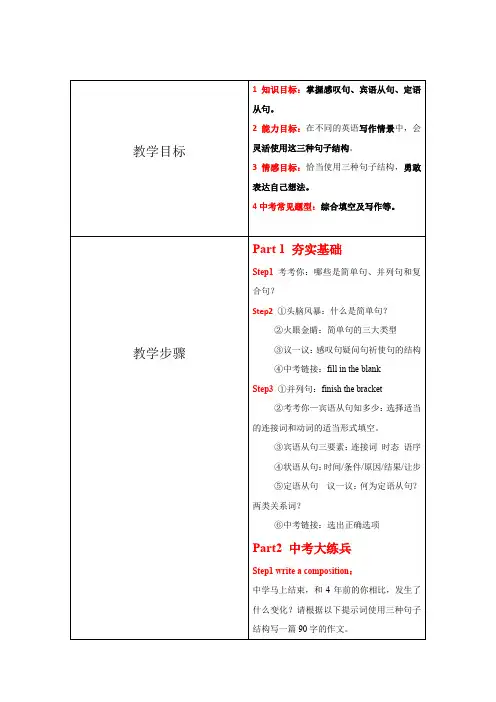
课后反思:本节课为复习课,课堂容量大,主要通过形式多样的活动来引导学生自己探究各种句子结构的规律,并在练习中加以巩固所学知识。
通过本节课的学习,学生能使用宾语从句、定语从句和状语从句等复杂句式,提高了学生的综合语言运用能力。
由于时间分配的关系,语言输出性任务较少,在以后教学设计过程中,应注重语言输出性环节。
效果分析:在本节课的学习过程中,师生互动高效。
学生先是初步感知三大句子结构,再次会做相关题目,最后能根据相关情景,将三大句子结构灵活运用于书面表达中。
能运用并列句、定语从句、宾语从句和状语从句,从口语表述到书面表达,描述自己现在和四年前的变化。
本节课为九年级复习课,主要依据教材为《初中学生学业考试手册》。
主要目标是使学生从宏观上理解句子的三种结构,即简单句、并列句和复合句。
一方面,学生在日常交际和写作中能根据不同情景灵活使用这些句子结构;另一方面,为高中学习奠定良好的基础。
其中,简单句包括感叹句、疑问句和祈使句。
并列句是由并列连词把两个或两个以上平等而又独立的分句连接而成的句子,不同并列连词可以表示并列句中不同的关系。
复合句,主要包括宾语从句、定语从句和状语从句。
本节课主要围绕这三种句子结构展开讲解,讲练结合。
最后,用一篇写作训练的方式,培养学生的综合实践能力。
一.考考你:哪些是简单句、并列句、复合句?1.I am a teacher.2.she teaches English.3.I am a teacher and you are a student.4.She said that she would study harder than before.5.This is the gift (that) he gives me.6.Although my Chinese teacher is strict, we love him.二.火眼金睛:简单句的三大类型1.What a kind girl (she is)!How carefully the old man walks!2. He never went there,did he?3. Which do you prefer, coffee or tea?4. Please (don’t) look back.三.议一议:感叹句、疑问句和祈使句的结构1.What+(a/an) (形容词)名词+主谓语!How+形容词/副词+主谓语!2.陈述句+简短问句(be、have、助动词、情态动词+主语)3.特殊疑问句/一般疑问句+第一个选项+or+第二个选项4.(don’t)动词原形+其他四.中考链接1.____fine weather we have today!2.____heavy the storm is!3.I don’t think Ken did such a stupid thing,______?4.Please give me a hand,____?五.宾语从句知多少选择适当的连接词或动词的恰当形式填空。
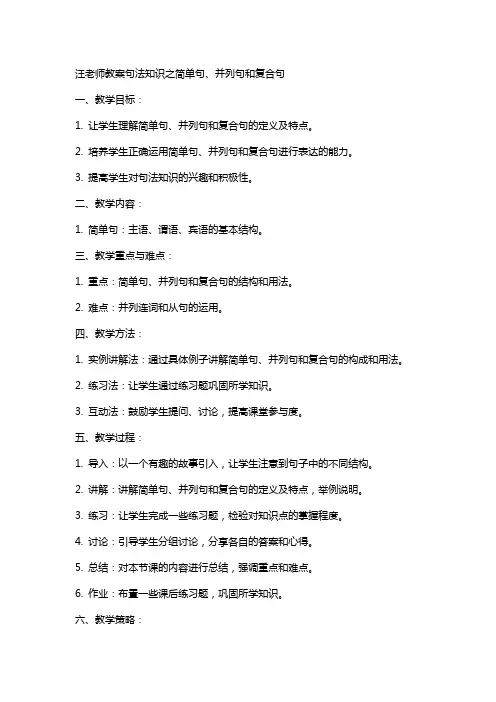
汪老师教案句法知识之简单句、并列句和复合句一、教学目标:1. 让学生理解简单句、并列句和复合句的定义及特点。
2. 培养学生正确运用简单句、并列句和复合句进行表达的能力。
3. 提高学生对句法知识的兴趣和积极性。
二、教学内容:1. 简单句:主语、谓语、宾语的基本结构。
三、教学重点与难点:1. 重点:简单句、并列句和复合句的结构和用法。
2. 难点:并列连词和从句的运用。
四、教学方法:1. 实例讲解法:通过具体例子讲解简单句、并列句和复合句的构成和用法。
2. 练习法:让学生通过练习题巩固所学知识。
3. 互动法:鼓励学生提问、讨论,提高课堂参与度。
五、教学过程:1. 导入:以一个有趣的故事引入,让学生注意到句子中的不同结构。
2. 讲解:讲解简单句、并列句和复合句的定义及特点,举例说明。
3. 练习:让学生完成一些练习题,检验对知识点的掌握程度。
4. 讨论:引导学生分组讨论,分享各自的答案和心得。
5. 总结:对本节课的内容进行总结,强调重点和难点。
6. 作业:布置一些课后练习题,巩固所学知识。
六、教学策略:1. 采用直观教学法,通过图片、实物等引导学生理解句子结构。
2. 运用任务型教学法,设计实际操作活动,让学生在实践中运用所学知识。
3. 创设情境,让学生在真实环境中练习口语表达,提高语言运用能力。
七、教学评价:1. 课堂参与度:观察学生在课堂上的发言、讨论等积极性。
2. 练习题完成情况:检查学生课后练习题的完成质量,了解对知识点的掌握程度。
3. 口语表达:评估学生在情境练习中的口语表达能力,发现问题及时反馈。
八、教学拓展:1. 对比分析不同语言的句子结构,探讨语言之间的差异和共性。
2. 介绍一些常用的并列连词和从句连接词,拓展学生的词汇知识。
3. 引导学生阅读一些复杂句子的文章,提高阅读理解能力。
九、教学资源:1. PPT课件:展示句子结构、例句等,方便学生直观理解。
2. 练习题:提供一些针对性的练习题,帮助学生巩固知识。
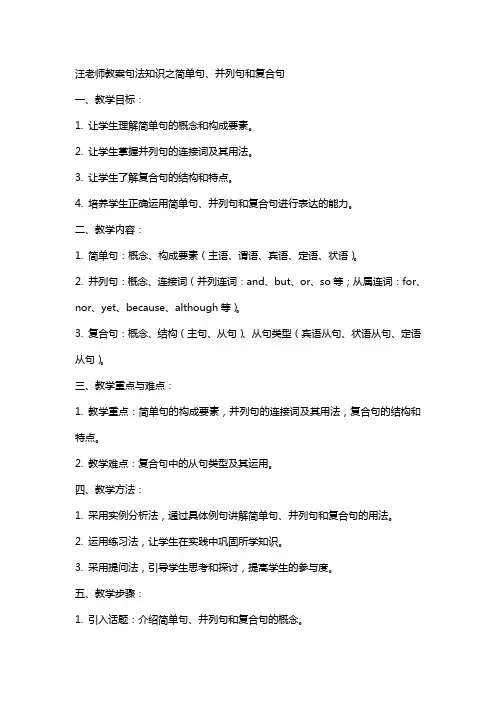
汪老师教案句法知识之简单句、并列句和复合句一、教学目标:1. 让学生理解简单句的概念和构成要素。
2. 让学生掌握并列句的连接词及其用法。
3. 让学生了解复合句的结构和特点。
4. 培养学生正确运用简单句、并列句和复合句进行表达的能力。
二、教学内容:1. 简单句:概念、构成要素(主语、谓语、宾语、定语、状语)。
2. 并列句:概念、连接词(并列连词:and、but、or、so等;从属连词:for、nor、yet、because、although等)。
3. 复合句:概念、结构(主句、从句)、从句类型(宾语从句、状语从句、定语从句)。
三、教学重点与难点:1. 教学重点:简单句的构成要素,并列句的连接词及其用法,复合句的结构和特点。
2. 教学难点:复合句中的从句类型及其运用。
四、教学方法:1. 采用实例分析法,通过具体例句讲解简单句、并列句和复合句的用法。
2. 运用练习法,让学生在实践中巩固所学知识。
3. 采用提问法,引导学生思考和探讨,提高学生的参与度。
五、教学步骤:1. 引入话题:介绍简单句、并列句和复合句的概念。
2. 讲解简单句:讲解主语、谓语、宾语、定语、状语的构成要素。
3. 讲解并列句:介绍并列连词和从属连词的用法。
4. 讲解复合句:讲解主句、从句的结构,介绍宾语从句、状语从句、定语从句的类型。
5. 课堂练习:让学生运用所学知识进行句子改写、句子填空等练习。
6. 总结与拓展:总结本节课所学内容,布置课后作业,引导学生进一步学习句法知识。
教学评价:通过课堂练习和课后作业,评估学生对简单句、并列句和复合句的掌握程度。
在课后进行反馈,针对学生的不足进行有针对性的辅导。
六、教学活动设计:1. 实例分析:分析一些日常生活中的句子,让学生区分简单句、并列句和复合句。
2. 小组讨论:让学生分组讨论,总结并列句和复合句的用法及其区别。
3. 角色扮演:设计一个场景,让学生运用所学知识进行角色扮演,实际运用简单句、并列句和复合句。
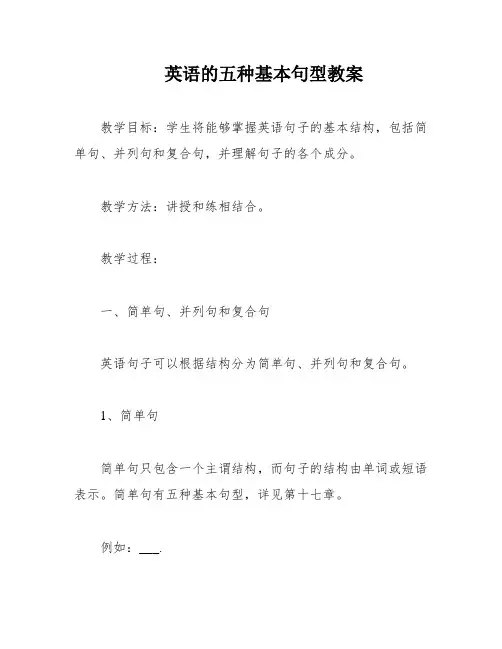
英语的五种基本句型教案教学目标:学生将能够掌握英语句子的基本结构,包括简单句、并列句和复合句,并理解句子的各个成分。
教学方法:讲授和练相结合。
教学过程:一、简单句、并列句和复合句英语句子可以根据结构分为简单句、并列句和复合句。
1、简单句简单句只包含一个主谓结构,而句子的结构由单词或短语表示。
简单句有五种基本句型,详见第十七章。
例如:___.他们正在公园里打棒球。
___.她的哥哥和姐姐都是老师。
2、并列句并列句由两个或两个以上的简单句连接而成。
并列句中的各简单句意义同等重要,相互之间没有从属关系,是平行并列的关系。
它们之间用连词连结。
例如:My friend was at home。
and we talked for a long time.我的朋友在家,我们谈了好长时间。
___。
___.她父亲是个医生,她母亲是个老师。
3、复合句复合句包含一个主句、一个或一个以上的从句,或只包含一个从句,但有两个或两个以上的主句的句子叫复合句。
例如:He said that he would ___.他说他明天会来。
I don't know where he is.我不知道他在哪里。
二、句子的成分句子成分包括:主语、谓语、表语、宾语(直接宾语、间接宾语)、宾语补足语、定语和状语。
主语和谓语是句子主体部分(在英文中一般的句子必须有主语和谓语)。
表语、宾语和宾语补足语是谓语里的组成部分。
其他成分如定语和状语是句子的次要部分。
下面我们分别讲述一下句子的各个成分:1、主语主语是谓语讲述的对象,表示所说的“是什么”或“是谁”。
一般由名词、代词、不定式或相当于名词的词或短语来充当。
它在句首。
例如:We study in No.1 Middle School.我们在一中研究。
The classroom is very clean.这间教室很干净。
Three ___.三个人缺席。
注意:文章中没有明显的格式错误和有问题的段落,因此不需要删除。
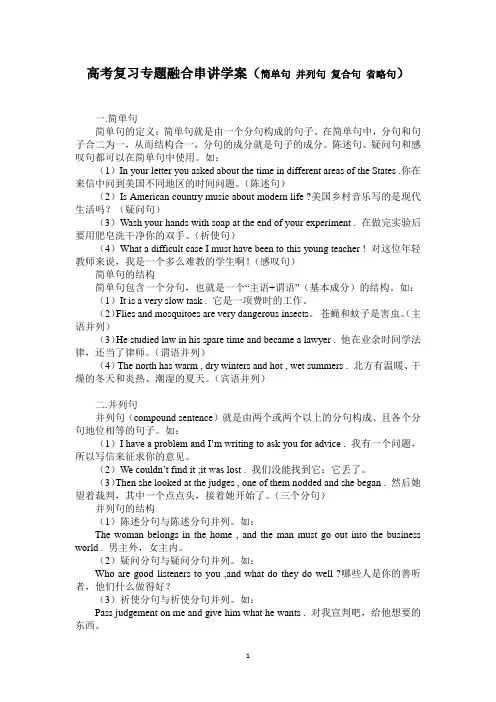
高考复习专题融合串讲学案(简单句并列句复合句省略句)一.简单句简单句的定义:简单句就是由一个分句构成的句子。
在简单句中,分句和句子合二为一,从而结构合一,分句的成分就是句子的成分。
陈述句、疑问句和感叹句都可以在简单句中使用。
如:(1)In your letter you asked about the time in different areas of the States .你在来信中问到美国不同地区的时间问题。
(陈述句)(2)Is American country music about modern life ?美国乡村音乐写的是现代生活吗?(疑问句)(3)Wash your hands with soap at the end of your experiment . 在做完实验后要用肥皂洗干净你的双手。
(祈使句)(4)What a difficult case I must have been to this young teacher ! 对这位年轻教师来说,我是一个多么难教的学生啊!(感叹句)简单句的结构简单句包含一个分句,也就是一个“主语+谓语”(基本成分)的结构。
如:(1)It is a very slow task . 它是一项费时的工作。
(2)Flies and mosquitoes are very dangerous insects。
苍蝇和蚊子是害虫。
(主语并列)(3)He studied law in his spare time and became a lawyer . 他在业余时间学法律,还当了律师。
(谓语并列)(4)The north has warm , dry winters and hot , wet summers . 北方有温暖、干燥的冬天和炎热、潮湿的夏天。
(宾语并列)二.并列句并列句(compound sentence)就是由两个或两个以上的分句构成、且各个分句地位相等的句子。
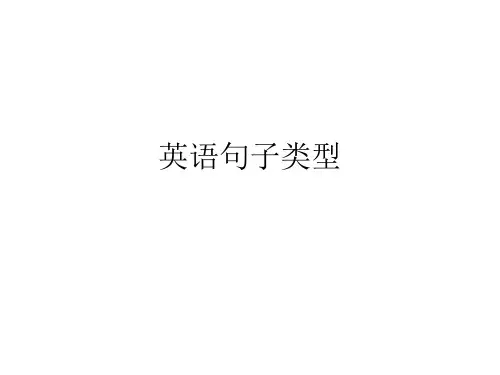
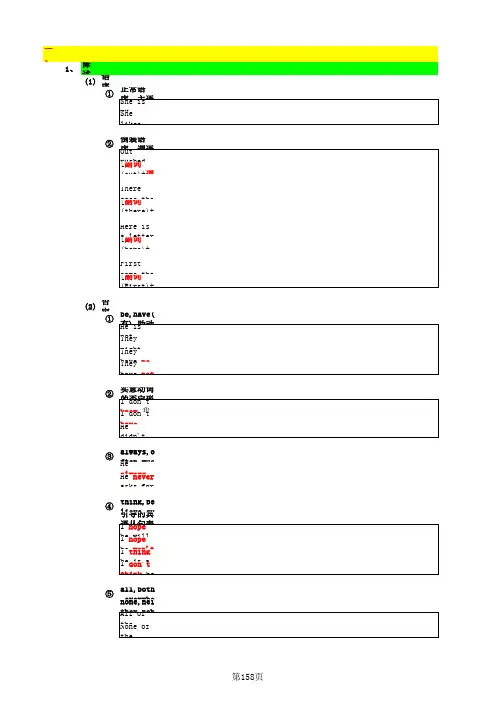
一、句子类型:1、陈述句:(1)语序:①②(2)否定形式:①②③always,often,much的否定形式分别是:never,seldom,little:He always asks for money.他总是要钱。
He never asks for money.他从来不要钱。
④think,believe,suppose,expect,imagine,guess,assume⑤all,both,everybody,somebody,everything,something的否定形式分别为:⑥⑦⑧肯定句中表“推测”的must的否定形式:can't肯定句中still的否定形式:not…any longer:2、疑问句:(1)一般疑问句:①②一般疑问句的回答:③(2)特殊疑问句:①②③(3)(4)反意疑问句:①②③④⑤如果主句是由主语(I,we)和谓语(think,believe,suppose,expect,imagine,⑥⑦⑧祈使句的反意疑问句:肯定祈使句表示“请求”用:will you:Let's引导的祈使肯定时用:shall we:Let us引导的祈使肯定时用:will you:3、感叹句:(1)一般感叹句:How+形容词(副词)+主+谓+其它!What+(a/an)+形容词+名词+主+谓+其它!(2)特殊感叹句:4、祈使句:(1)祈使句的种类:①②③④⑤(2)(3)祈使句的特殊用法:①②③(4)二、简单句:1、主语+不及物动词:Evening came.夜晚来临了。
2、主语+系动词+表语:The students are on the playground.学生们在操场上。
3、主语+及物动词+宾语:The students clean the classroom every day.学生们每天打扫教室。
4、主语+及物动词+间宾+直宾:The little boy is always asking the teacher questions.这个小男孩总爱问老师问题。
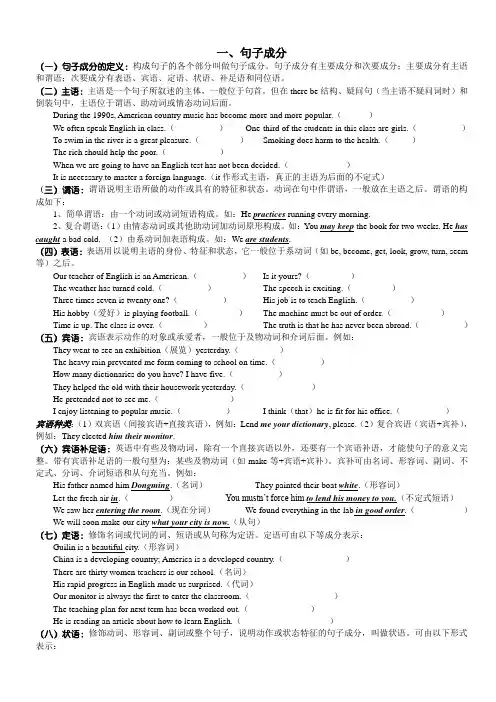
一、句子成分(一)句子成分的定义:构成句子的各个部分叫做句子成分。
句子成分有主要成分和次要成分;主要成分有主语和谓语;次要成分有表语、宾语、定语、状语、补足语和同位语。
(二)主语:主语是一个句子所叙述的主体,一般位于句首。
但在there be结构、疑问句(当主语不疑问词时)和倒装句中,主语位于谓语、助动词或情态动词后面。
During the 1990s, American country music has become more and more popular.()We often speak English in class.()One-third of the students in this class are girls.()To swim in the river is a great pleasure.()Smoking does harm to the health.()The rich should help the poor.()When we are going to have an English test has not been decided.()It is necessary to master a foreign language.(it作形式主语,真正的主语为后面的不定式)(三)谓语:谓语说明主语所做的动作或具有的特征和状态。
动词在句中作谓语,一般放在主语之后。
谓语的构成如下:1、简单谓语:由一个动词或动词短语构成。
如:He practices running every morning.2、复合谓语:(1)由情态动词或其他助动词加动词原形构成。
如:You may keep the book for two weeks. He has caught a bad cold. (2)由系动词加表语构成。
如:We are students.(四)表语:表语用以说明主语的身份、特征和状态,它一般位于系动词(如be, become, get, look, grow, turn, seem 等)之后。
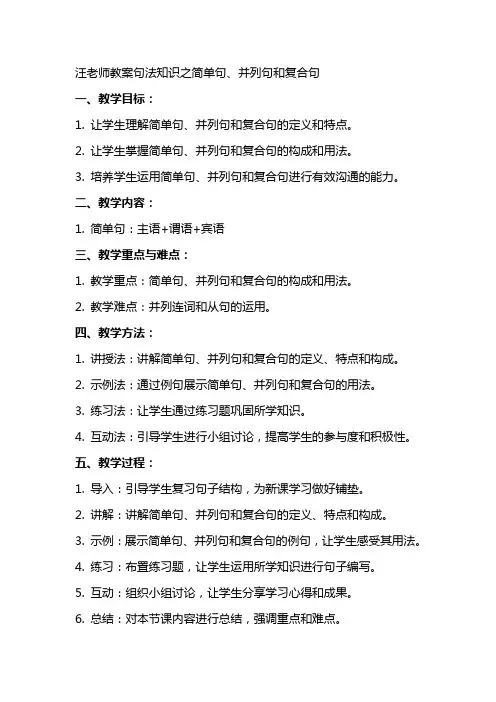
汪老师教案句法知识之简单句、并列句和复合句一、教学目标:1. 让学生理解简单句、并列句和复合句的定义和特点。
2. 让学生掌握简单句、并列句和复合句的构成和用法。
3. 培养学生运用简单句、并列句和复合句进行有效沟通的能力。
二、教学内容:1. 简单句:主语+谓语+宾语三、教学重点与难点:1. 教学重点:简单句、并列句和复合句的构成和用法。
2. 教学难点:并列连词和从句的运用。
四、教学方法:1. 讲授法:讲解简单句、并列句和复合句的定义、特点和构成。
2. 示例法:通过例句展示简单句、并列句和复合句的用法。
3. 练习法:让学生通过练习题巩固所学知识。
4. 互动法:引导学生进行小组讨论,提高学生的参与度和积极性。
五、教学过程:1. 导入:引导学生复习句子结构,为新课学习做好铺垫。
2. 讲解:讲解简单句、并列句和复合句的定义、特点和构成。
3. 示例:展示简单句、并列句和复合句的例句,让学生感受其用法。
4. 练习:布置练习题,让学生运用所学知识进行句子编写。
5. 互动:组织小组讨论,让学生分享学习心得和成果。
6. 总结:对本节课内容进行总结,强调重点和难点。
7. 作业:布置课后作业,巩固所学知识。
六、教学活动:1. 复习上节课的内容,通过提问方式检查学生对简单句、并列句和复合句的理解。
2. 进行一个小组活动,让学生用简单句、并列句和复合句描述一幅图片,并互相交流。
七、课堂练习:1. 布置练习题,让学生区分简单句、并列句和复合句,并给出实例。
2. 让学生运用所学知识,编写一段对话或短文,要求使用不同类型的句子。
八、案例分析:1. 提供一些句子,让学生分析其句子结构,判断其为简单句、并列句还是复合句。
2. 分析一些复杂的句子,让学生理解从句和状语从句的用法。
九、语法讲解:1. 讲解并列连词的用法,如并列连词and, but, or等。
2. 讲解从句的分类和用法,如时间状语从句、地点状语从句等。
十、课堂小结:1. 对本节课的内容进行总结,强调简单句、并列句和复合句的构成和用法。
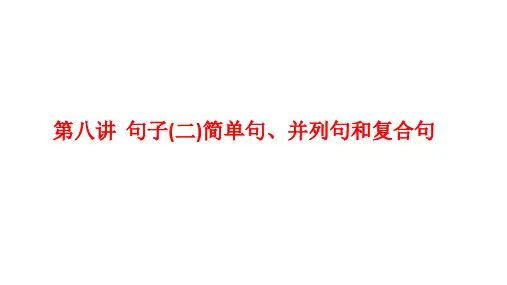
教师学科教案[ 20 – 20 学年度第__学期]任教学科:_____________任教年级:_____________任教老师:_____________xx市实验学校有关简单句、复合句及并列句的知识疏理:授课教师:卫老师(1)定义:只有一个主语(或并列主语)和一个谓语(或并列谓语)的句子叫简单句,如:We learn English . 我们学英语。
(一个主语和一个谓语)(2)分类:上次我们对简单句按照句子基本结构分出的5种类型做了阐述;另外,根据句子的功能或使用目的,简单句可分四类:陈述句、疑问句、祈使句、感叹句。
(1)定义:用并列连接词连接起来的两个或两个以上简单句叫做并列句。
(2)并列句的构成:简单句+连接词+简单句(3)连接并列句常用的连接词:and , but , or , so , not only … but also , however , neither…nor , either…or , still等。
(1)定义:主从复合句是由一个主句和一个或一个以上的从句构成的。
主句是句子的主体,从句可视作句子的一个成分。
从句在主从复合句中可起主语、宾语、表语、定语、状语作用。
从句在全句中起什么作用,就叫什么从句。
(2)状语从句:状语从句在句中起状语作用,修饰主句中的谓语动词、形容词或副词。
在初中阶段我们主要学习了以下几种状语从句:①时间状语从句:常见引导词:when(当……时),as(一边……一边,当……时),while(在……过程中),before(在……以前),after(在……之后),since (自从……以来),till(until)(直到……,直到……才),as soon as(一……就……)等。
②原因状语从句:常由because(因为),since(既然),as(由于)等连接词引导。
③地点状语从句:常由where(在……地方),wherever(无论……在哪儿)等连接词引导。